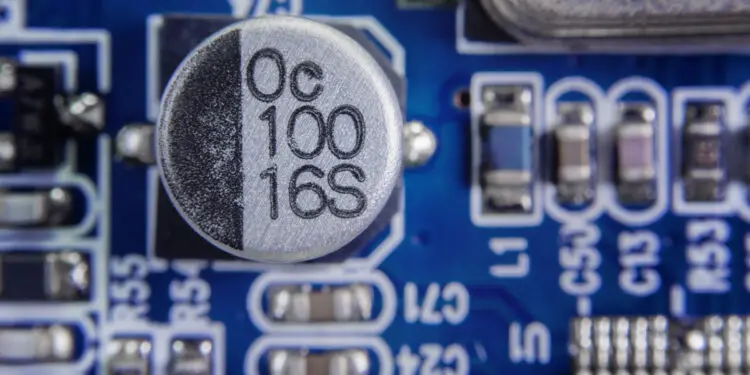The article explains impact of low temperature to behaviour of aluminium electrolytic capacitors.
Construction of Aluminum Electrolytic Capacitors
Life all other capacitors, an aluminum electrolytic capacitor comprises of two layers of a conductive material separated by a layer of a dielectric material. An aluminum foil of extremely high purity is used as the anode while a conductive liquid (electrolyte) is used as the cathode. The two aluminum foils of an aluminum electrolytic capacitor provide a large contact area required to allow current to pass to the conductive operating electrolyte. To achieve high capacitance values, the effective contact area of the anode is usually enlarged by electrochemical etching. The type and degree of etching is determined by the desired effective contact area.
An aluminum electrolytic capacitor utilizes an aluminum oxide layer (Al2O3) as the dielectric, allowing production of high capacitance components with very thin layers of dielectric material, often less than 1 µm in thicknesses. This thin dielectric layer in conjunction with the large contact area of the etched anode, means that aluminum electrolytic capacitors offer a higher capacitance per unit area than other dielectric families.
Low Temperature Characteristics of Aluminum Electrolytic Capacitors
Various parameters of aluminum electrolytic capacitors, including operating temperatures and electrical ratings, are greatly influenced by the characteristics of the electrolyte. The properties of the liquid electrolyte that are considerably affected by temperature variations include electrical conductivity and viscosity. The electrical conductivity of the electrolyte increases with an increase in temperature and reduces with a decrease in temperature. Temperature variations have more effect on the characteristics of aluminum electrolytic capacitors than on other types of capacitors. Some of the functional parameters for aluminum electrolytic capacitors that are considerably affected by changes in temperature include capacitance, equivalent series resistance (ESR), tangent delta, leakage current, and impedance.
Capacitance
Temperature changes have significant effects on the capacitance of an aluminum electrolytic capacitor. As the temperature of the electrolyte decreases, its viscosity increases resulting in a reduced electrical conductivity. Therefore, the capacitance of aluminum electrolytic capacitors reduces with a decrease in temperature. At low frequencies, the relationship between temperature and capacitance of aluminum electrolytic capacitors is nearly linear. When operating at -400C, low-voltage aluminum electrolytic capacitors with a low temperature rating of -550C exhibit a capacitance loss of between -10% and -20%. Capacitance loss for high-voltage capacitors can be up to 40%. When operating at the low-temperature limit, the capacitance of aluminum electrolytic capacitors with a low temperature rating of -550C declines by less than 20%.
Equivalent Series Resistance (ESR)
The resistive component of an equivalent series circuit of a capacitor is referred to as the equivalent series resistance (ESR). The ESR of aluminum electrolytic capacitors is considerably affected by variations in temperature and frequency. In wet aluminum electrolytic capacitors, drastic changes in capacitance are observed when temperature drops. The changes in capacitance are mainly due to the effect of temperature variation on the electrolyte, rather than on the dielectric. The resistivity of the electrolyte increases with a decrease in temperature. For instance, when the temperature drops from 250C to -550C, the resistivity of the electrolyte can increase by a factor of about 100, resulting in a considerable increase in ESR. In wet aluminum capacitors, dramatic changes in ESR are observed as the temperature decreases. For an aluminum electrolytic capacitor operating at the low-temperature limit, the ESR is more than 10 times. If a capacitor with a low-temperature rating of -200C is operated at -400C, its equivalent series resistance can increase by more than a factor of two.
Leakage Current
The leakage current of an electrolytic capacitor is primarily dependent on the characteristics of the dielectric material. Crystal defects, cracks, stress, and installation-related damages are some of the main causes of leakage current. Although the value of leakage current can be decreased by minimizing these defects, it cannot be fully eliminated. The key factors that affect leakage current include temperature, time, applied voltage, and the design of a capacitor. The leakage current increases with an increase in temperature and reduces with a decrease in temperature. For aluminum electrolytic capacitors, this functional parameter is usually stable at low temperatures. In addition, the initial leakage current of an aluminum electrolytic capacitor is dependent on storage duration and conditions.
Impedance
The impedance of an aluminum electrolytic capacitor is dependent on frequency and temperature. It comprises capacitive reactance of the capacitor, ohmic and dielectric losses of the foils, electrolyte, and terminals, and inductive reactance of the capacitor windings. The capacitive reactance and the equivalent series resistance depend on both frequency and temperature, while inductive reactance depends on frequency only. The impedance of an aluminum electrolytic capacitor increases with a decrease in temperature. When an aluminum electrolytic capacitor is operating at its low-temperature limit, it impedance increases by up to 10 times.
Dissipation Factor (Tangent of Loss Angle or Tan δ)
Dissipation factor or tangent of loss angle of a capacitor refers to the ratio of equivalent series resistance to capacitive reactance. The dissipation factor of an aluminum electrolytic capacitor is dependent on both temperature and frequency. This parameter increases with a decrease in temperature. When operating at the low-temperature limit, the dissipation factor of an aluminum electrolytic capacitor with a low temperature rating of -550C increases more than 10 times. When the same capacitor is operated at -400C, the parameter increases up to 5 times.































